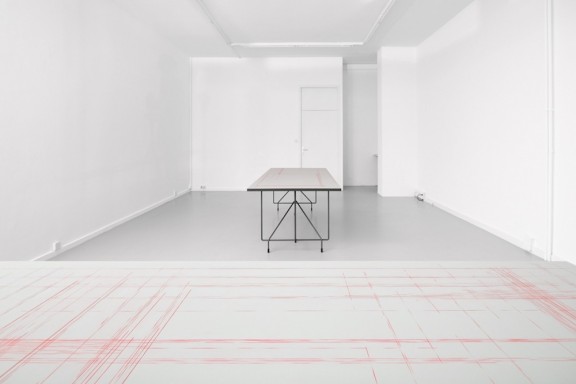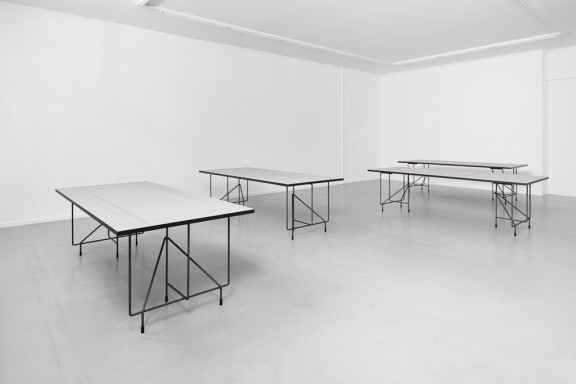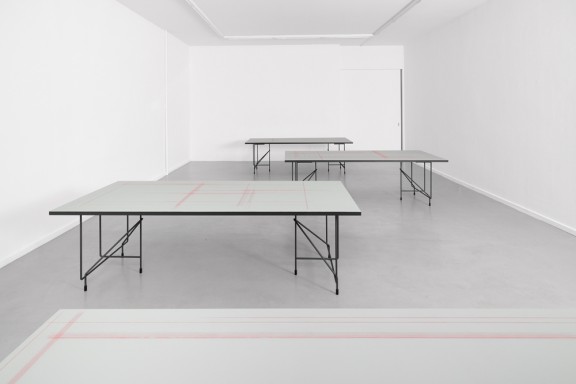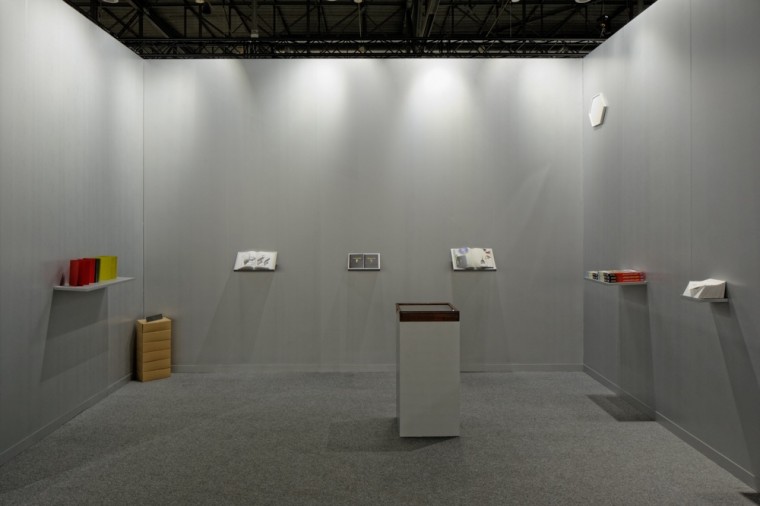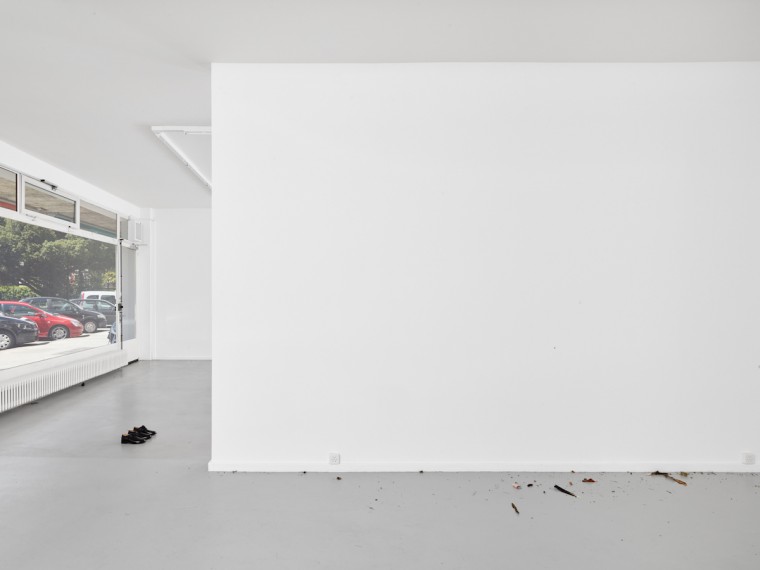David Maljkovic
with
Konstantin Grcic
Negatives
Exhibition from March 20 to May 16, 2015
For his exhibition at the CEC, David Maljkovic will create, in collaboration with the German designer Konstantin Grcic, a series of works called Negatives. The “negatives” began with Maljkovic’s Temporary Projections in 2011. For this project, the artist created a fictional studio as a projection and one of the elements in the studio was a ‘fake’ working table. In collaboration with Grcic, the table is now an actual object, and what was once a secondary element becomes a model and the focus of the work. The “negatives”, then, are tables designed by Grcic that Maljkovic transforms by using as a work surface. As the artist cuts into paper with a blade, he leaves slashes and marks on the soft surface of the table top. The result is a group of intersecting lines and marks that combine to make a geometric abstraction. Red ink is then applied to this surface, and paper applied, in a process that resembles printmaking, leaving the table top marks filled with a vibrant red. The ‘negative’ is this structure that provided a space for the edition-making process.
The work of David Maljkovic demonstrates a high degree of formalist imagination. Whatever the narrative or subject matter that prompts a project, the result does not just mediate or describe this narration, but encrypts it, even comments upon it from above, to open up new semantic processes. His work investigates the arbitrary relationship between form and content, signifier and signified, and this investigation is the key preoccupation and strategy of his artistic process. In these gaps, Maljkovic exposes the erosion of memory and the corruption of information, confronting the visitor with a wearing down of meanings and a destabilisation of our senses through the effects of time and technology. As a response to this defective memory, Maljkovic has adopted collage as a formal principle, recombining photographs, films, projected images and sound pieces from his own personal archive. He makes use of operations of dislocation, subtraction and juxtaposition to move towards new conceptual horizons.
Negatives are a result of a close collaboration between the designer Konstantin Grcic and David Maljkovic. The works will oscillate between functional tables and sculpture, between the multiple and the unique object, in a collaboration where one creates the support for an artwork and the other offers a transition into a hybrid object.
In their two-headed collaboration, the production of the artist and that of the designer merge. On the one hand there is the passion of David Maljkovic for architecture and design that are some of the many references that constitute the central body of his work. Some recent productions of Konstantin Grcic on the other hand maintain an esthetical relationship with the works of Jeff Koons, James Turrell or Larry Bell. The common points between Maljkovic and Grcic lie in their interest for industrial design, and more in particular for the world of automobiles. We find this fascination in Maljkovic’s film Out of Projection (2009) produced on the test ramps of the Peugeot factory in Sochaux, in which we can see old aerodynamic and retro-futuristic racing cars. For Grcic, this same taste for automobiles was indisputably expressed in his table collection Champions (2011) whose profile of the legs and structure supporting the table top resemble spoilers of racing cars or motorbike fuselage, varnished in bright colours and customised by a logo coming from the world of sport cars, sportswear, ski or that of bikers.
This very physical and mechanical approach of Konstantin Grcic probably comes from his first training as a cabinetmaker, and from one of his first mentors’, Jasper Morrison’s « for real life » design, and also from another referential figure, Vico Magistretti, who developed more geometrical and industrial forms. Konstantin Grcic’s design is characterized by sharp, efficient, mechanical and hi-tech structures. One of his most recent series, Man Machine (2014), a glass line with silicone and pistons, refers to Kraftwerk’s eponymous electronic music album. Some of his objects are close to mechanics, robotics, kind of machines célibataires in which Grcic engages in advanced research regarding the quality of the materials, new technology and the process of production. Radically functional, his inventions are also multifunctional and sometimes narrative, humorous or even exuberant like the pavilion for the Audi stand at the Design Miami/Basel Fair 2014. Built from Audi TT doors, the structure oscillates between the shed and the spaceship. Grcic comically subverts elements from the world of luxury cars and in a perfectly DIY spirit turns them into an ephemeral and composite structure, just the same way as he did with Paramount (2012), a toy for poodles edited by Architecture for Dogs. This dressing table for stars is in reality a « Mirror Test », a test that enables to control if poodles are a part of those few animals capable of recognising themselves in the mirror. Design for all in a way.
David Maljkovic is a Croatian artist, born in 1973 in Rijeka (Croatia). He lives and works in Zagreb. Among his recent solo exhibitions: Palais de Tokyo, Paris, Van Abbemuseum, Eindhoven, BALTIC Centre for Contemporary Art, Gateshead, GAMeC, Bergamo, Museo Reina Sofia, Madrid, Secession, Vienna, Whitechapel, London, CAPC musée d’art Contemporain, Bordeaux, Kunstmuseum St.Gallen, CAC Vilnius, Kunsthalle Basel, SculptureCenter, New York, MoMA PS1. His work has been included in group shows at Kunsthaus Bregenz, MAXXI Rome, MUSAC Museo de Arte Contemporáneo de Castilla y Léon, Spain, The Power Plant, Toronto, Wiels, Brussels, Centre Pompidou, Paris, La Triennale 2012, Paris, 29th São Paulo Biennial, 9th and 11th Istanbul Biennial. His work is part of major public collections such as Centre Pompidou, Paris, MUMOK, Vienna, Museo Reina Sofia, Madrid, MoMA, New York, Stedelijk Museum, Amsterdam and Tate Collection, London.
Konstantin Grcic is a German designer, born in 1965 in Munich. He was trained as a cabinetmaker at the John Makepeace School (Dorset, England) before studying Design at the Royal College of Art in London. After studies, he worked for Jasper Morrison, a British designer, and he established his own practice in Munich in 1991: Konstantin Grcic, Industrial Design (KGID). Since then, he develops and creates furniture and products for various leading companies in the field of design, such as Mattiazzi, Muji or Vitra. He received international design awards, among which the Compasso d’Oro that he received twice: for his Mayday lamp in 2001 and for his Myto chair in 2007. Grcic was in charge of the design exhibition of the German Pavilion at the 13th Architecture Biennial in Venice and showed his works in numerous exhibitions such as at the Kreo Gallery in Paris (2004), the Museum Boijmans Van Beuningen in Rotterdam (2006), Haus der Kunst in Munich (2006) and at the Art Institute in Chicago (2009). Some of his creations are part of the permanent collections of important museums, such as MoMA, Musée des arts décoratifs and the Centre Georges Pompidou in Paris. In March 2014, the Vitra Design Museum in Weil-am-Rheim dedicated a massive retrospective to Grcic’s work entitled Panorama covering 25 years of designer’s work.
David Maljkovic is also exhibiting at Blondeau & Cie, 5 rue de la Muse, 1205 Geneva
David Maljkovic
New Collection
From March 20 to May 9, 2015
